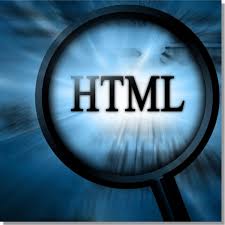What is HTML in Blogger?
HTML stands for HYPER TEXT MARKUP LANGUAGE.
HTML defines the structure and layout of a Web document by using a variety of tags and attributies. The correct structure for an HTML document starts with <HTML><HEAD>(enter here what document is about)<BODY> and ends with </BODY></HTML>. All the information you'd like to include in your Web page fits in between the <BODY> and </BODY> tags.
 HTML is a formal Recommendation by the World Wide Web Consortium (W3C) and is generally adhered to by the major browsers, Microsoft's Internet Explorer and Netscape's Navigator, which also provide some additional non-standard codes. The current version of HTML is HTML 4.0. However, both Internet Explorer and Netscape implement some features differently and provide non-standard extensions. Web developers using the more advanced features of HTML 4 may have to design pages for both browsers and send out the appropriate version to a user. Significant features in HTML 4 are sometimes described in general as dynamic HTML. What is sometimes referred to as HTML 5 is an extensible form of HTML called Extensible Hypertext Markup Language (XHTML).
HTML is a formal Recommendation by the World Wide Web Consortium (W3C) and is generally adhered to by the major browsers, Microsoft's Internet Explorer and Netscape's Navigator, which also provide some additional non-standard codes. The current version of HTML is HTML 4.0. However, both Internet Explorer and Netscape implement some features differently and provide non-standard extensions. Web developers using the more advanced features of HTML 4 may have to design pages for both browsers and send out the appropriate version to a user. Significant features in HTML 4 are sometimes described in general as dynamic HTML. What is sometimes referred to as HTML 5 is an extensible form of HTML called Extensible Hypertext Markup Language (XHTML).
HTML stands for HYPER TEXT MARKUP LANGUAGE.
HTML defines the structure and layout of a Web document by using a variety of tags and attributies. The correct structure for an HTML document starts with <HTML><HEAD>(enter here what document is about)<BODY> and ends with </BODY></HTML>. All the information you'd like to include in your Web page fits in between the <BODY> and </BODY> tags.
There are hundreds of other tags used to format and layout the information in a Web page. Tags are also used to specify hypertext links. These allow Web developers to direct users to other Web pages with only a click of the mouse on either an image or words.
HTML (Hypertext Markup Language) is the set of markup symbols or codes inserted in a file intended for display on a World Wide Web browser page. The markup tells the Web browser how to display a Web page's words and images for the user. Each individual markup code is referred to as an element (but many people also refer to it as a tag). Some elements come in pairs that indicate when some display effect is to begin and when it is to end.
0 comments :
Post a Comment